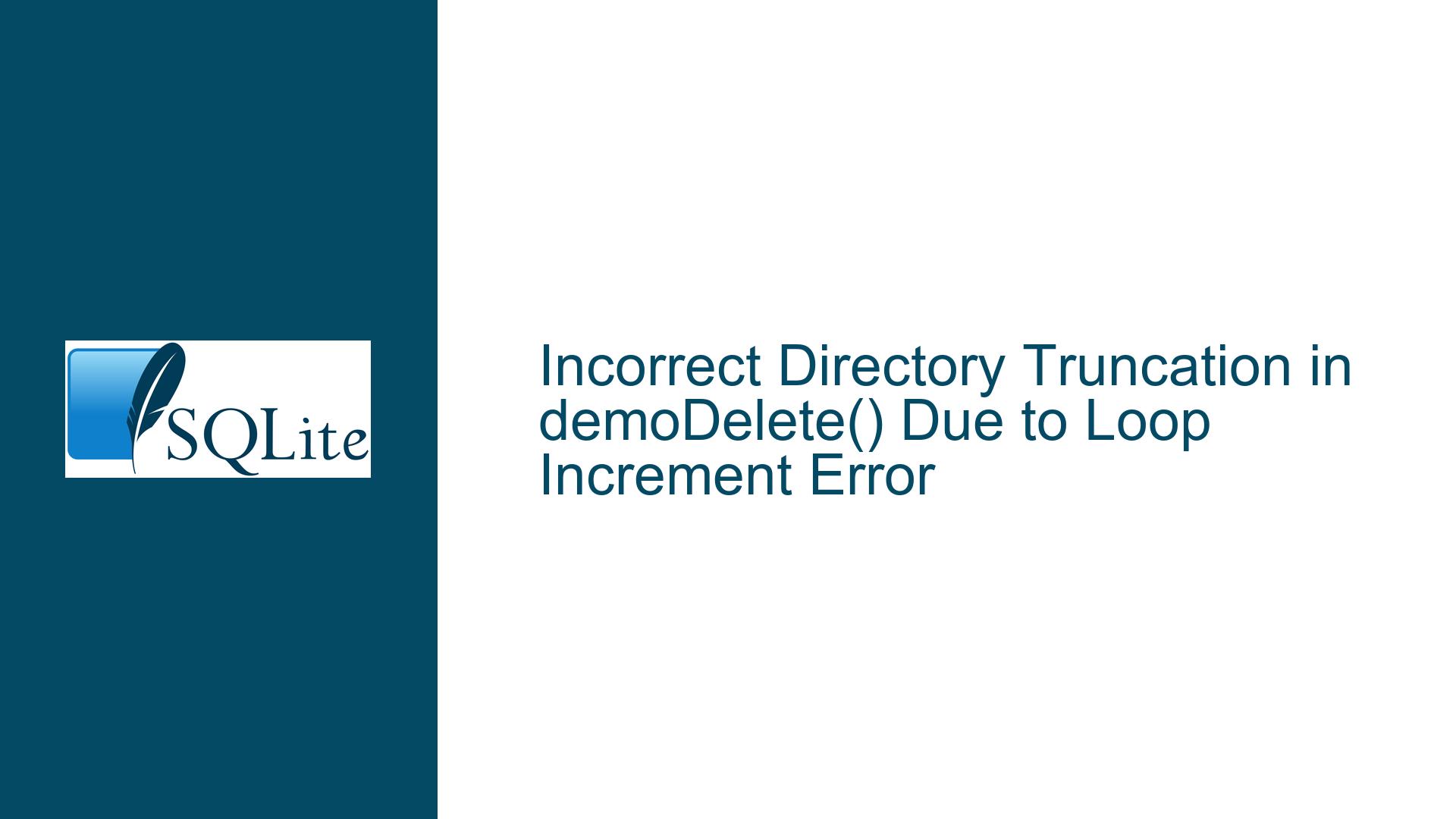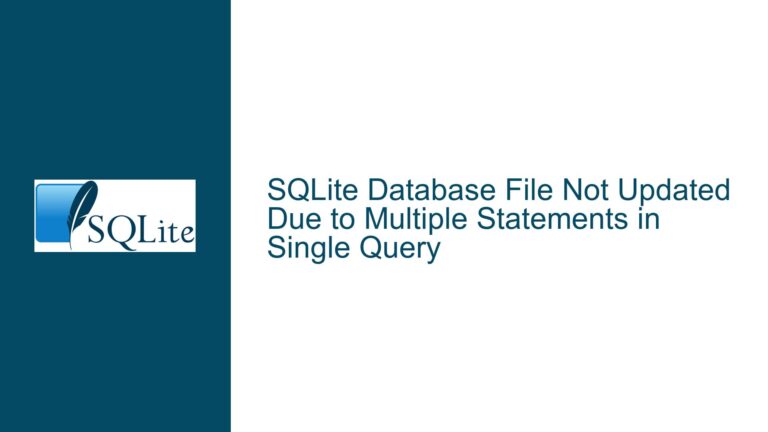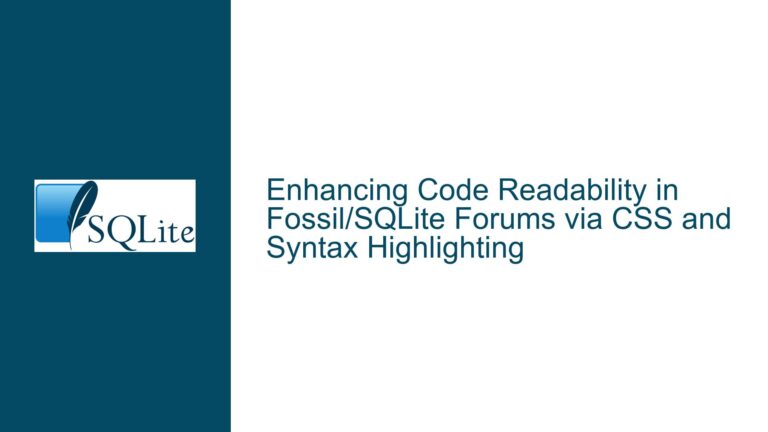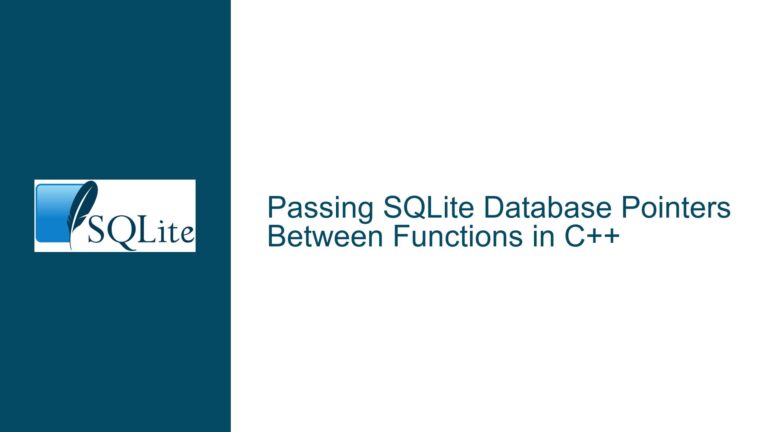Incorrect Directory Truncation in demoDelete() Due to Loop Increment Error
Issue Overview: Path Parsing Failure in demoDelete()’s Directory Extraction Logic
The core issue in the provided demoDelete() function stems from improper handling of directory path extraction when attempting to synchronize the directory (dirSync) after deleting a file. The function is part of a custom Virtual File System (VFS) implementation in SQLite, designed to demonstrate how to extend SQLite’s file system abstraction. The critical failure occurs when parsing the input file path (zPath) to isolate the parent directory path (zDir), which is required for directory synchronization via fsync().
Key Code Segment Analysis
The problematic code block is:
sqlite3_snprintf(MAXPATHNAME, zDir, "%s", zPath);
zDir[MAXPATHNAME] = '\0';
for(i=strlen(zDir); i>1 && zDir[i]!='/'; i++);
zDir[i] = '\0';
Here, zDir is initialized as a copy of zPath. The for loop attempts to locate the last occurrence of the slash (/) in zDir to truncate the string at that position, isolating the directory. However, the loop increments i instead of decrementing it, causing it to iterate in the wrong direction. This results in incorrect truncation of zDir, leading to invalid directory paths and subsequent failures in directory synchronization.
Impact of the Issue
- Directory Synchronization Failures: When
dirSyncis enabled (non-zero), the function attempts to open and synchronize the directory containing the deleted file. An invalid directory path causesopen(zDir, ...)to fail, returningdfd < 0, which setsrc = -1and ultimately returnsSQLITE_IOERR_DELETE. - Data Integrity Risks: If
fsync()is not performed on the correct directory, the file deletion might not be durable, risking data corruption after crashes or power failures. - Silent Failures: The error may go unnoticed because the function returns
SQLITE_OKif the file does not exist (errno==ENOENT), masking synchronization failures when the directory path is invalid.
Technical Context
- VFS Layer in SQLite: The VFS layer abstracts file system operations, allowing SQLite to work across different platforms. Custom VFS implementations like the "demo" VFS must correctly handle path manipulation, file descriptors, and synchronization.
- Path Truncation Logic: Isolating the directory from a full file path requires identifying the last slash (
/) in the path string. For example, given/var/data/file.txt, the directory is/var/data. - Loop Semantics: The loop starts at
i = strlen(zDir), which points to the null terminator of the string. Incrementingimoves the index beyond the null terminator, violating string boundaries and causing undefined behavior.
Possible Causes: Misindexing and Directional Iteration in Path Parsing
1. Off-by-One Error in Initial Loop Index
The loop initializes i to strlen(zDir), which is the index of the null terminator. Since C strings are zero-indexed, the last valid character is at strlen(zDir) - 1. Starting at strlen(zDir) means the loop begins outside the string bounds, leading to invalid memory access when checking zDir[i].
2. Incrementing Instead of Decrementing the Loop Counter
The loop uses i++ instead of i--, causing it to iterate forward through memory addresses beyond the string’s end. This prevents the loop from ever finding the last slash unless the null terminator coincidentally matches /, which is impossible. The loop condition i>1 further complicates this by allowing i to start at very large values (e.g., 4096 for a max path), exacerbating out-of-bounds access.
3. Incorrect Termination Condition for Directory Truncation
The loop terminates when i>1 && zDir[i]!='/' becomes false. However, because i is incremented, the loop stops only when i exceeds the string length or zDir[i] is a slash. In practice, this condition is never met, causing the loop to run indefinitely or until i exceeds system limits, resulting in a buffer overrun.
4. Lack of Bounds Checking for Short Paths
If the input path has no slashes (e.g., file.txt in the current directory), the loop fails to isolate the directory correctly. After truncation, zDir becomes an empty string or an invalid path, causing open() to fail.
Troubleshooting Steps, Solutions & Fixes: Correcting Path Truncation Logic
Step 1: Identify the Correct Loop Initialization and Direction
The loop should start at the last valid character of zDir and iterate backward until a slash is found or the start of the string is reached. Modify the loop initialization and direction as follows:
for(i = strlen(zDir) - 1; i >= 0 && zDir[i] != '/'; i--);
- Explanation:
i = strlen(zDir) - 1starts at the last character before the null terminator.i--decrements the index, moving backward through the string.- The loop terminates when
i < 0or a slash is found.
Step 2: Handle Edge Cases for Root Directories and No-Slash Paths
After the loop, handle cases where no slash is found (e.g., file.txt in the current directory):
if (i <= 0) {
// No slash found; default to current directory (".")
zDir[0] = '.';
zDir[1] = '\0';
} else {
zDir[i] = '\0';
}
- Explanation: If no slash is found, set
zDirto.to represent the current directory. This ensuresopen()can synchronize the correct directory.
Step 3: Validate the Modified Code
Test the corrected code with various paths:
- Absolute Path:
/var/data/file.txt- Loop stops at
i = 8(slash beforefile.txt), truncating to/var/data.
- Loop stops at
- Relative Path:
data/file.txt- Loop stops at
i = 4, truncating todata.
- Loop stops at
- No Slash:
file.txt- Loop ends with
i = -1, settingzDirto..
- Loop ends with
Step 4: Add Defensive Bounds Checking
Ensure i does not underflow when the path is empty or malformed:
int len = strlen(zDir);
if (len == 0) {
// Handle empty path error
return SQLITE_IOERR_DELETE;
}
for(i = len - 1; i >= 0 && zDir[i] != '/'; i--);
Step 5: Test Directory Synchronization
After fixing the loop, verify that fsync() is called on the correct directory:
dfd = open(zDir, O_RDONLY, 0);
if (dfd < 0) {
// Log error for debugging
fprintf(stderr, "Failed to open directory: %s\n", zDir);
rc = -1;
} else {
rc = fsync(dfd);
close(dfd);
}
Final Corrected Code
static int demoDelete(sqlite3_vfs *pVfs, const char *zPath, int dirSync){
int rc;
rc = unlink(zPath);
if( rc!=0 && errno==ENOENT ) return SQLITE_OK;
if( rc==0 && dirSync ){
int dfd;
int i;
char zDir[MAXPATHNAME+1];
sqlite3_snprintf(MAXPATHNAME, zDir, "%s", zPath);
zDir[MAXPATHNAME] = '\0';
int len = strlen(zDir);
for(i = len - 1; i >= 0 && zDir[i] != '/'; i--);
if (i <= 0) {
// Handle no slash or root directory
zDir[0] = '.';
zDir[1] = '\0';
} else {
zDir[i] = '\0';
}
dfd = open(zDir, O_RDONLY, 0);
if( dfd<0 ){
rc = -1;
}else{
rc = fsync(dfd);
close(dfd);
}
}
return (rc==0 ? SQLITE_OK : SQLITE_IOERR_DELETE);
}
Summary of Fixes
- Loop Initialization: Start at
strlen(zDir) - 1to avoid null terminator. - Loop Direction: Decrement
iwithi--to iterate backward. - Edge Case Handling: Set
zDirto.if no slash is found. - Bounds Checking: Prevent underflow and invalid indices.
By addressing these issues, the demoDelete() function will correctly isolate the directory path, ensuring reliable synchronization and adherence to SQLite’s VFS requirements.






